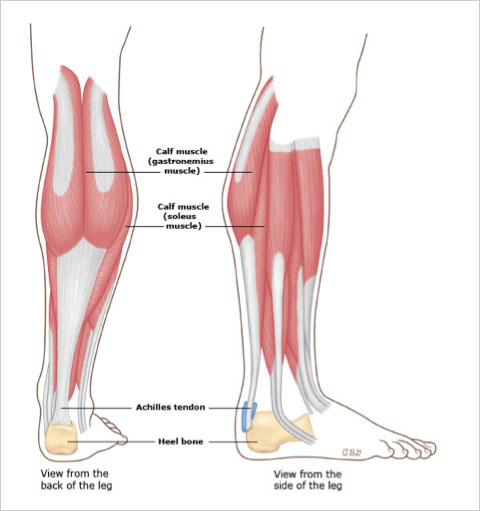
What is Achilles Tendinopathy?
Achilles tendinopathy (sometimes called Achilles tendinitis) is a condition that causes pain in the back of the leg, just above the heel. It happens when people hurt their Achilles tendon. Tendons are strong bands of tissue that connect muscles to bones. The Achilles tendon connects the calf muscles to the heel bone

You use your Achilles tendon when you walk, run, and jump.
What causes Achilles tendinopathy?
Achilles tendinopathy can happen when people:
- Suddenly increase their exercise or activity (such as running)
- Do the same exercises or activities (such as jumping) over and over
- Don’t warm up their calf muscles before exercising
- Exercise in shoes or sneakers that are worn-out or not made for exercise
- Have arthritis or a bone growth on the back of their heel bone – This can rub against the tendon and hurt it.
What are the symptoms of Achilles tendinopathy?
The most common symptoms are:
- Pain in the back of the leg, just above the heel – The pain usually gets worse with exercise and better with rest.
- Stiffness or soreness in the back of the leg, especially in the morning
- Swelling of the skin over the Achilles tendon
- Trouble standing on tiptoe
Sometimes, an Achilles tendon tears. Doctors call this a “rupture.” Symptoms of an Achilles tendon rupture can include:
- Sudden, severe pain in the back of the leg
- Trouble putting weight on the foot or walking normally
Is there a test for Achilles tendinopathy?
No. But your doctor should be able to tell if you have it by learning about your symptoms and doing an exam. Your doctor might order an X-ray or other test to check if another condition is causing your symptoms.
If your doctor thinks that you tore your Achilles tendon, you might have an imaging test called an MRI. This test can create pictures of the tendon.
How is Achilles tendinopathy treated?
Achilles tendinopathy usually gets better on its own, but it can take months to heal completely. To help your symptoms get better, you can:
- Rest your Achilles tendon and avoid activities that cause pain
- Ice the area – Put a cold gel pack, bag of ice, or bag of frozen vegetables on the injured area every 1 to 2 hours, for 15 minutes each time. Put a thin towel between the ice (or other cold object) and your skin.
- Wrap your ankle with an elastic bandage (or other wrap) – This can help keep your tendon from moving too much. Your doctor or nurse will show you how to wrap your ankle correctly.
- Take medicine to reduce the pain and swelling – Your doctor might recommend that you take a “nonsteroidal anti-inflammatory drug” or “NSAID.” NSAIDs are a group of medicines that includes ibuprofen and naproxen.
- Do exercises to make your calf muscles stronger – Your doctor or physical therapist (exercise expert) will show you which exercises to do.
What if my symptoms don’t get better?
If your symptoms don’t get better, your doctor might suggest other possible treatments. These can include:
- A device to wear in your shoe or around your ankle to keep your foot in a position where it can heal properly
- Surgery
Is there anything I can do to keep from getting tendinopathy again?
Yes. To lower the chance of getting Achilles tendinopathy again, you can:
- Warm up your muscles before you exercise. For example, if you run, you can warm up your muscles by jogging slowly and then slowly increasing your pace.
- Avoid sudden increases in your exercise or activity. When you begin a sport or activity, start off slowly. Over time, you can exercise harder and for longer periods of time.
- Avoid running or exercising outside in cold weather. If you need to be outside, wear warm clothes.
- Wear the correct sneakers or shoes for your sport or activity.
- Replace worn-out sneakers or shoes.
- Avoid running on hard surfaces.
